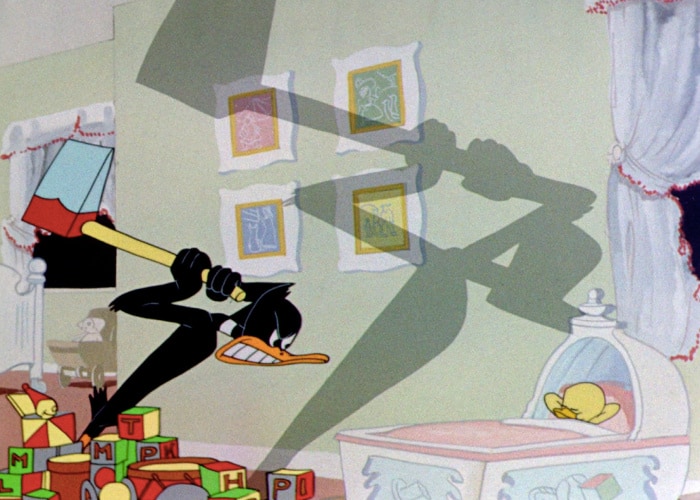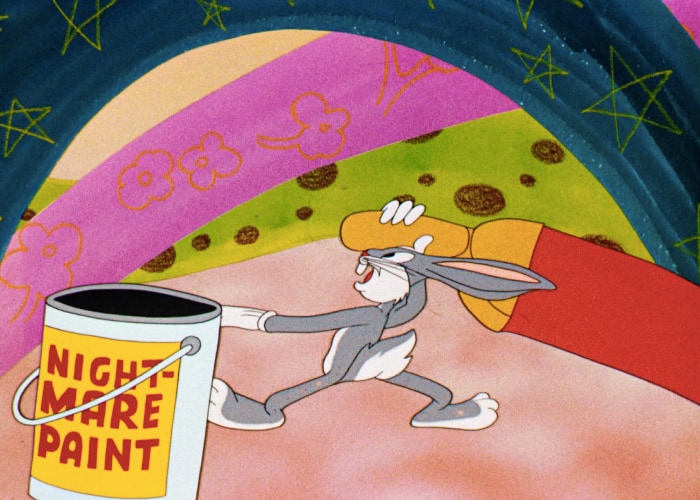The Wretched Pleasures and Psychotic Education of ‘Looney Tunes’
Welcome to Saturday Morning Cartoons, our new weekly column where we continue the animated boob tube ritual of yesteryear. Our lives may no longer be scheduled around small screen programming, but that doesn’t mean we should forget the necessary sanctuary of Saturday ‘toons.
There is no better parade of maniacs than Looney Tunes. The desperate psychotics of Bugs Bunny, Sylvester the Cat, Tweety, Daffy Duck, and Wile E. Coyote, forged the morality of generations of children. We paid attention, and we learned how not to behave even while we took great pleasure in their depravity.
Eager to compete against Walt Disney’s rising tide of animated shorts, Warner Bros. created Looney Tunes and Merrie Melodies to steal the hearts of America’s youth. Under the leadership of producer Leon Schlesinger, a stable of creative nutjobs formed. Pioneers like Tex Avery, Friz Freleng (a.k.a. I. Freleng), Robert Clampett, and Chuck Jones poured their lunacy upon the screen, pushing their characters into wild directions that Disney’s gang couldn’t comprehend. Their heroes were terrors, and dammit, we love to watch ’em terrorize.
You’ll cringe gazing into Looney Tunes and Merrie Melodies today. They’re filled with dark actions and darker thoughts. Throughout their initial, untouchable run (1933 – 1964), you’ll find all manner of questionable behavior with nearly every one of your favorite characters partaking in violent, devious schemes.
Below, I’ve pulled out a handful of classic shorts, each one focusing on a favorite Looney Tunes hero. They’re all compelling glimpses of monstrous behavior, with only one champion rising golden and haloed above the rest. Can you guess which one? He’s no maroon.
Satan’s Waitin’ (1954)

Sylvester is a creature with a mean appetite. He’s gotta eat, and his hunger doesn’t discriminate. He’ll go for fish, mice, or garbage. If it’s around, it’s going down.
Yet, Sylvester knows a delicacy when he sees it. Tweety is not all feathers. The little chirper has plenty of meat under there. He wants him, and he wants him bad.
In Satan’s Waitin’, Sylvester chases Tweety off a rooftop. Tweet’s got wings. Sylvester does not. The cat plummets a skyscraper’s distance into the hard cement below. His spirit leaves his body and takes the long elevator pointing south.
Hell is run by demon dogs, but before Sylvester can get on with his eternity of torture, he must wait for his other eight lives to meet up with him. One demon dog goes above ground to speed things along, and for the rest of the cartoon, we watch Sylvester’s leftover lives deplete rather rapidly.
We take joy in watching Sylvester’s greed meet its end over and over and over again. We must remember to let some treats go. When the universe tells you it’s not meant to be, please listen.
Nasty Quacks (1945)

Daffy Duck is one-hundred-percent original. There ain’t nothing like him. He takes pride in his individuality, and that’s why jerkwads like Bugs Bunny drive him so damn crazy.
When Bugs is around, Daffy cannot win. When the rabbit is nowhere to be found, he has a bit of a chance to end on top. It won’t be easy, but he’ll fight like the devil.
In Nasty Quacks, we meet Daffy when he’s a wee little duckling. A beefy suburban dad purchased Daffy as a present for his darling daughter. She adores Daffy to no end…as a duckling. Daffy inevitably grows up and transforms into the monster we know and love.
Daddy can’t stand the terror, but he can’t kill the duck while his daughter remains ga-ga. A lightbulb pops above dear old Dad’s head! He merely needs to purchase a new duckling to distract his daughter while he sends Daffy to his grave.
Such action is diabolical, but Daffy knows the score. He sneaks up to the new duckling’s bedroom with an ax raised and ready to strike, but the darn thing is too cute, and for a change, Daffy cannot consent to such violent action. Instead, he pumps the duckling full of growth pills, and the little critter springs into one smokin’ hot lady duck. Dad returns home from work and finds his house overrun by Daffy’s progeny.
Daddy’s craven ego deserves Daffy’s madness. Nine times out of ten, the duck gets his comeuppance, but only when there is a bigger jerk in the neighborhood will he stand victorious. Daffy needs his wins to survive all his losses against the rabbit.
Beep Prepared (1961)

You must admire Wile E. Coyote’s dogged determination. We’ve never seen him wrap his mitts around the Road Runner, but he refuses to give up. There is always one more scheme to attempt, one more invention to concoct. In his heart of hearts, Wile E. Coyote believes he’ll get his dinner sooner rather than later.
Beep Prepared is six minutes long. In that time, we see Wile E. Coyote transform his body into a bow and arrow, plummet through his own portable pothole, explode inside a Da Vinci-inspired bat-costume, magnetically propel himself into a freight train, drop a boulder meant for Road Runner onto his head, and sever his torso with machine gunfire. The canine can’t take a hint.
When one action fails, he thinks of a bigger and more explosive endeavor. The short concludes with Wile E. Coyote constructing a DIY rocket sled, which obviously misses its mark and sends the darn coyote into space where he erupts into fireworks, forming a constellation. The Road Runner escapes with beeping glee once more.
Wile E. Coyote is an admirable chump. He’s the living embodiment of Samuel Becket’s Worstward Ho philosophy, “Try again. Fail again. Fail better.” There is no other option for him.
The Big Snooze (1946)

There is no greater asshole than Bugs Bunny. He’s filled with just as much devilish greed, wickedness, and treachery as Sylvester, Daffy Duck, and Wile E. Coyote, but the trickster gods of Looney Tunes let him get away with murder. He relishes in being a stinker.
Now, to be fair, he’s often caught in a scenario where the other guy is trying to pump his body full of bullets. Elmer Fudd is no better than Wile E. Coyote, always on the hunt for a poor little animal who would rather be munching on carrots than dodging buckshot.
The Big Snooze opens just before Fudd hits his limit. He sees the game. He recognizes that he’ll never catch the rabbit, and as a result, he tears up his Warner Bros. contract. The time to retire has arrived.
Bugs Bunny enjoys this reprieve for all of about five seconds. If Elmer Fudd quits, then Bugs could lose his source of income as well. He needs the hunter to play his role.
The rabbit finds Elmer Fudd enjoying a nice, leisurely nap on a knoll. There will be none of that. Bugs pops a few sleeping pills and goes full-Freddy Krueger on Elmer Fudd’s dreamscape. The invasion transforms a serene playground into a nightmarish hellscape where Bugs brutalizes Fudd’s psyche to the point where contractual enslavement feels like a relief.
No good-natured viewer could leave this tune on Team Bugs. The delight in which the rabbit molests Fudd’s fantasies is grotesque. We laugh only to relieve ourselves of the horror being perpetrated. Fudd may have the guns, but he certainly doesn’t have the brains. No weak-willed fool deserves the wrath that Bugs Bunny unleashes.
Wholly Smoke (1938)

Now, Porky Pig, he’s no jerk. He struggles. He falls. He’s mocked and belittled. He keeps charging.
Porky Pig is as determined and stubborn as Wile E. Coyote, but rather than being fed by hunger or revenge, he moves forever forward via good cheer and a solid heart. He does his best, and that’s enough.
Wholly Smoke is a prime example of Porky Pig’s righteous goodwill. The short begins with our hero promising to deliver his mother’s nickel to the church collection plate. On his chipper stroll through town, Porky runs into a young punk sucking a stogie and performing various tricks of smoke.
Porky is not a perfect pig. He succumbs to temptation. He bets the punk that he can perform tricks as equal if not better. Porky, of course, fails miserably.
Through a swamp of smoke, Porky wanders into a cigar shop. He is greeted by an anthropomorphic cloud, who lures him further down the treacherous road of drugs and desire. Terrified, Pork Pig escapes, runs back to the bully, steals back the nickel, and thrusts the coin into the church collection plate. He promises God that he will never smoke again.
Porky Pig is a good egg. He slips into immorality, but he never wallows in it. He leaves such behavior to Sylvester, Daffy, Wile E. Coyote, and Bugs. He may not be the coolest or the most fun to hang with, but whatever path he leads us down, he always provides a light of escape.
Porky Pig is the model we should follow. The rest of the Looney Tunes are the warnings.





